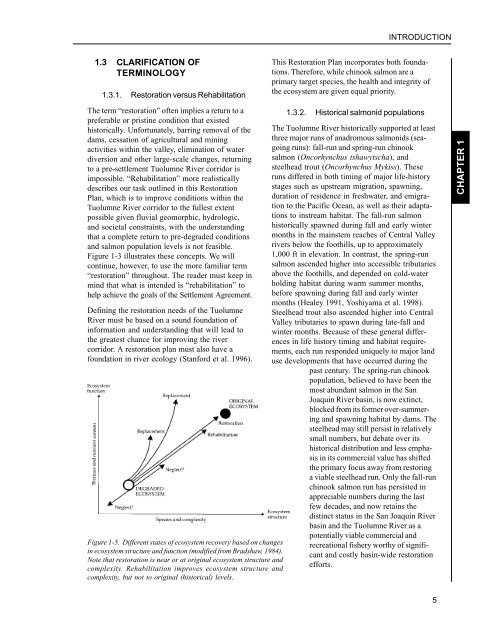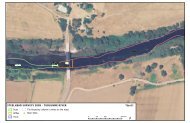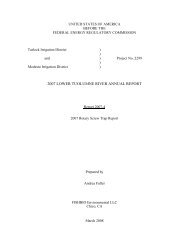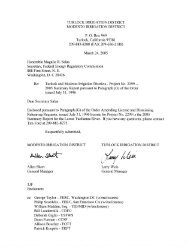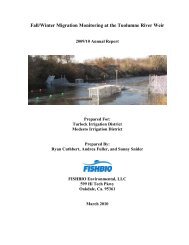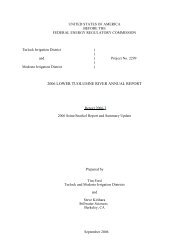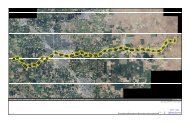Tuolumne River Report - U.S. Fish and Wildlife Service
Tuolumne River Report - U.S. Fish and Wildlife Service
Tuolumne River Report - U.S. Fish and Wildlife Service
Create successful ePaper yourself
Turn your PDF publications into a flip-book with our unique Google optimized e-Paper software.
INTRODUCTION1.3 CLARIFICATION OFTERMINOLOGY1.3.1. Restoration versus RehabilitationThe term “restoration” often implies a return to apreferable or pristine condition that existedhistorically. Unfortunately, barring removal of thedams, cessation of agricultural <strong>and</strong> miningactivities within the valley, elimination of waterdiversion <strong>and</strong> other large-scale changes, returningto a pre-settlement <strong>Tuolumne</strong> <strong>River</strong> corridor isimpossible. “Rehabilitation” more realisticallydescribes our task outlined in this RestorationPlan, which is to improve conditions within the<strong>Tuolumne</strong> <strong>River</strong> corridor to the fullest extentpossible given fluvial geomorphic, hydrologic,<strong>and</strong> societal constraints, with the underst<strong>and</strong>ingthat a complete return to pre-degraded conditions<strong>and</strong> salmon population levels is not feasible.Figure 1-3 illustrates these concepts. We willcontinue, however, to use the more familiar term“restoration” throughout. The reader must keep inmind that what is intended is “rehabilitation” tohelp achieve the goals of the Settlement Agreement.Defining the restoration needs of the <strong>Tuolumne</strong><strong>River</strong> must be based on a sound foundation ofinformation <strong>and</strong> underst<strong>and</strong>ing that will lead tothe greatest chance for improving the rivercorridor. A restoration plan must also have afoundation in river ecology (Stanford et al. 1996).Figure 1-5. Different states of ecosystem recovery based on changesin ecosystem structure <strong>and</strong> function (modified from Bradshaw, 1984).Note that restoration is near or at original ecosystem structure <strong>and</strong>complexity. Rehabilitation improves ecosystem structure <strong>and</strong>complexity, but not to original (historical) levels.This Restoration Plan incorporates both foundations.Therefore, while chinook salmon are aprimary target species, the health <strong>and</strong> integrity ofthe ecosystem are given equal priority.1.3.2. Historical salmonid populationsThe <strong>Tuolumne</strong> <strong>River</strong> historically supported at leastthree major runs of anadromous salmonids (seagoingruns): fall-run <strong>and</strong> spring-run chinooksalmon (Oncorhynchus tshawytscha), <strong>and</strong>steelhead trout (Oncorhynchus Mykiss). Theseruns differed in both timing of major life-historystages such as upstream migration, spawning,duration of residence in freshwater, <strong>and</strong> emigrationto the Pacific Ocean, as well as their adaptationsto instream habitat. The fall-run salmonhistorically spawned during fall <strong>and</strong> early wintermonths in the mainstem reaches of Central Valleyrivers below the foothills, up to approximately1,000 ft in elevation. In contrast, the spring-runsalmon ascended higher into accessible tributariesabove the foothills, <strong>and</strong> depended on cold-waterholding habitat during warm summer months,before spawning during fall <strong>and</strong> early wintermonths (Healey 1991, Yoshiyama et al. 1998).Steelhead trout also ascended higher into CentralValley tributaries to spawn during late-fall <strong>and</strong>winter months. Because of these general differencesin life history timing <strong>and</strong> habitat requirements,each run responded uniquely to major l<strong>and</strong>use developments that have occurred during thepast century. The spring-run chinookpopulation, believed to have been themost abundant salmon in the SanJoaquin <strong>River</strong> basin, is now extinct,blocked from its former over-summering<strong>and</strong> spawning habitat by dams. Thesteelhead may still persist in relativelysmall numbers, but debate over itshistorical distribution <strong>and</strong> less emphasisin its commercial value has shiftedthe primary focus away from restoringa viable steelhead run. Only the fall-runchinook salmon run has persisted inappreciable numbers during the lastfew decades, <strong>and</strong> now retains thedistinct status in the San Joaquin <strong>River</strong>basin <strong>and</strong> the <strong>Tuolumne</strong> <strong>River</strong> as apotentially viable commercial <strong>and</strong>recreational fishery worthy of significant<strong>and</strong> costly basin-wide restorationefforts.CHAPTER 15


